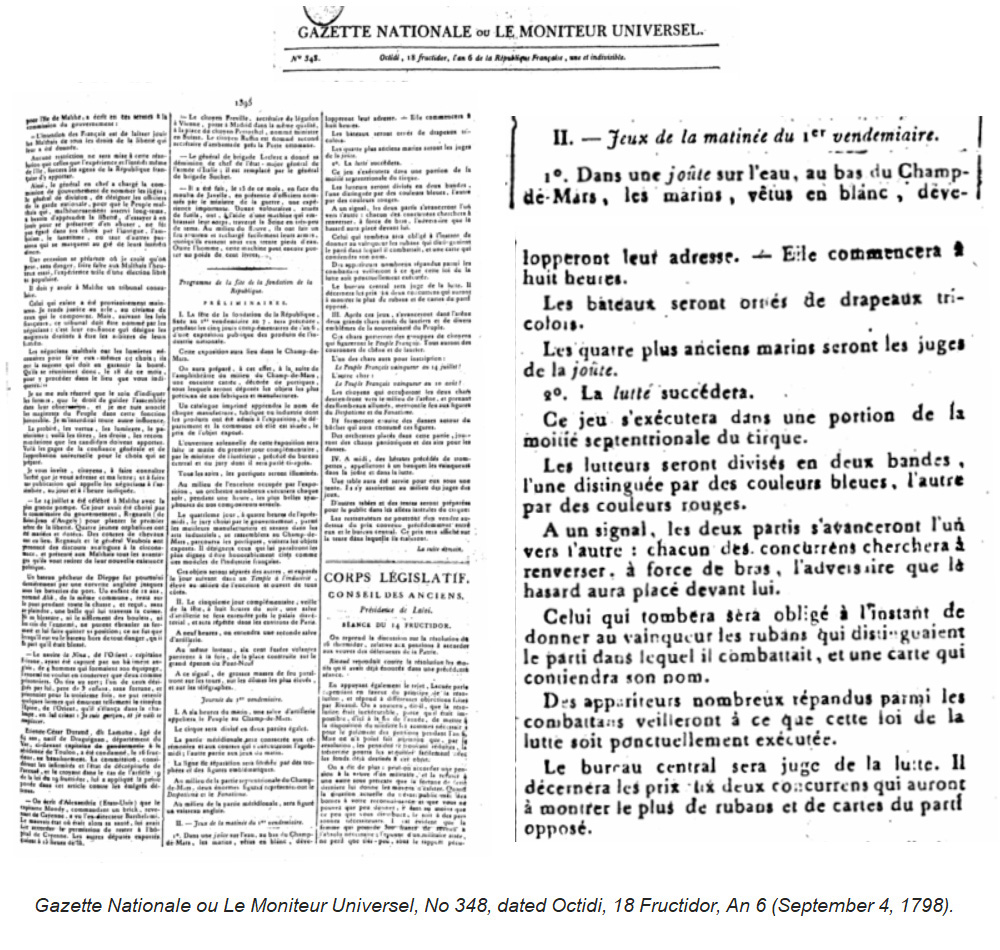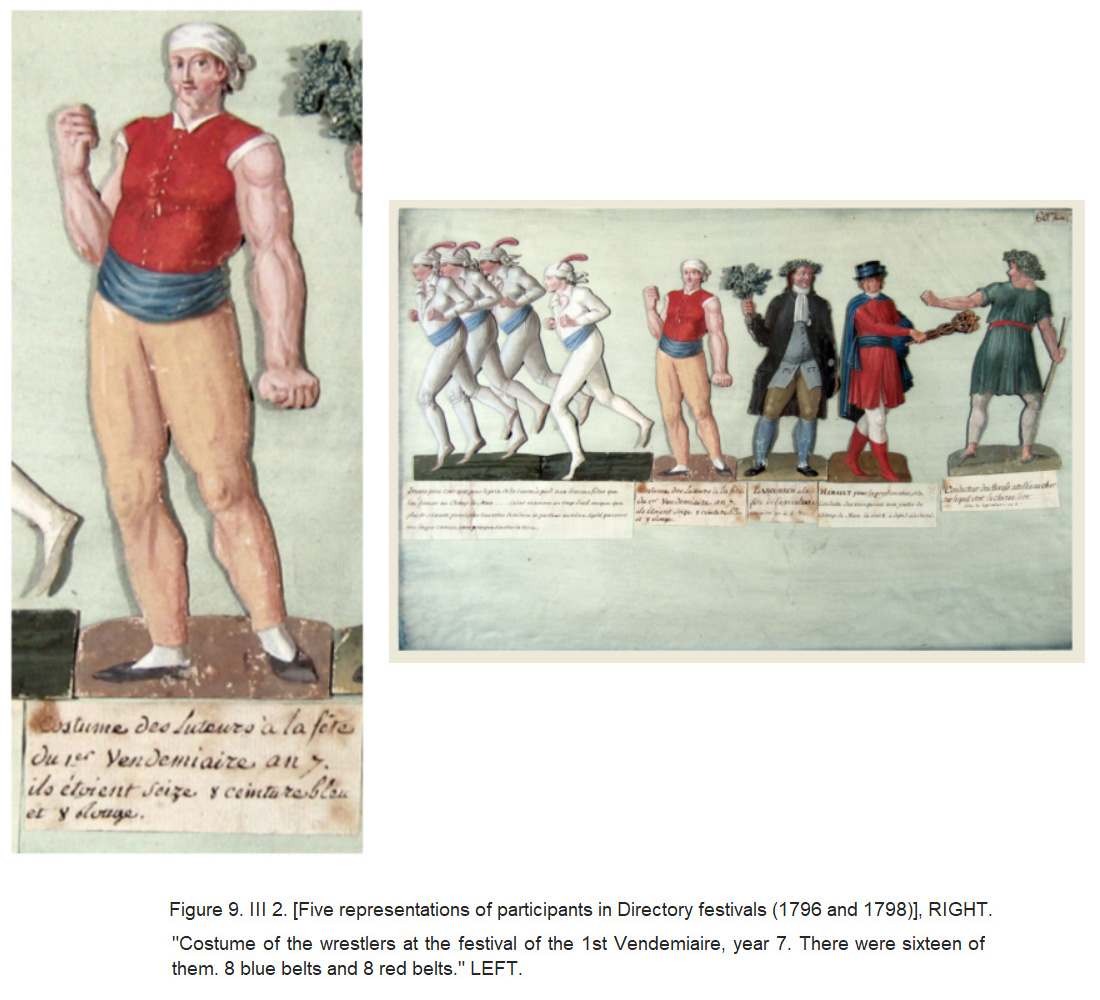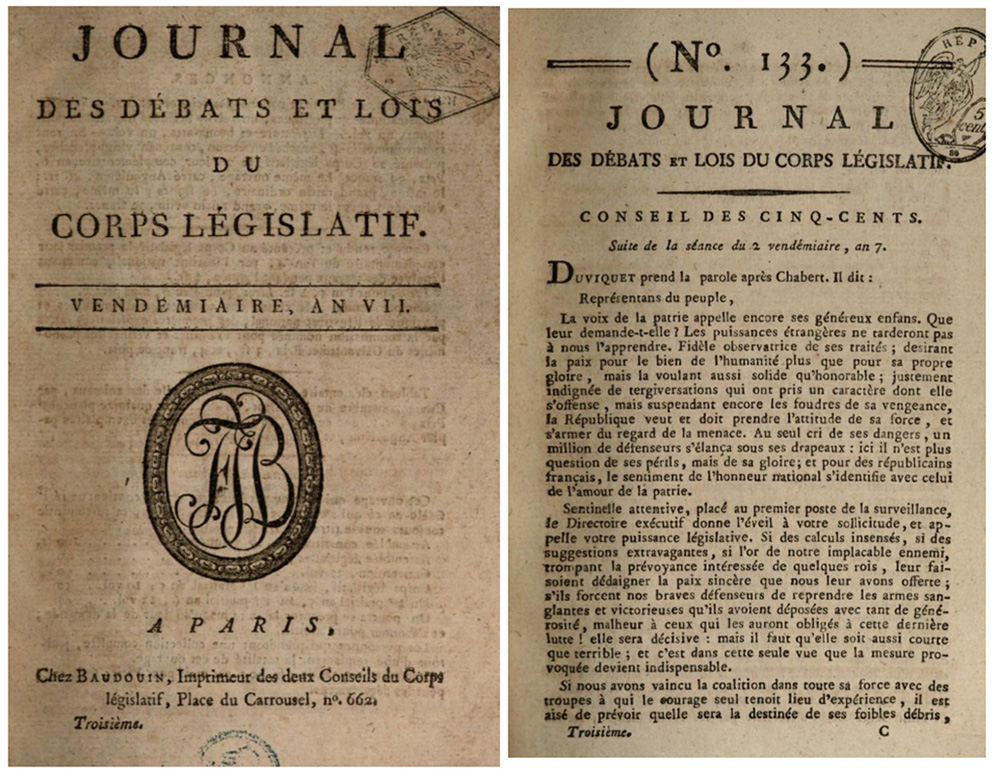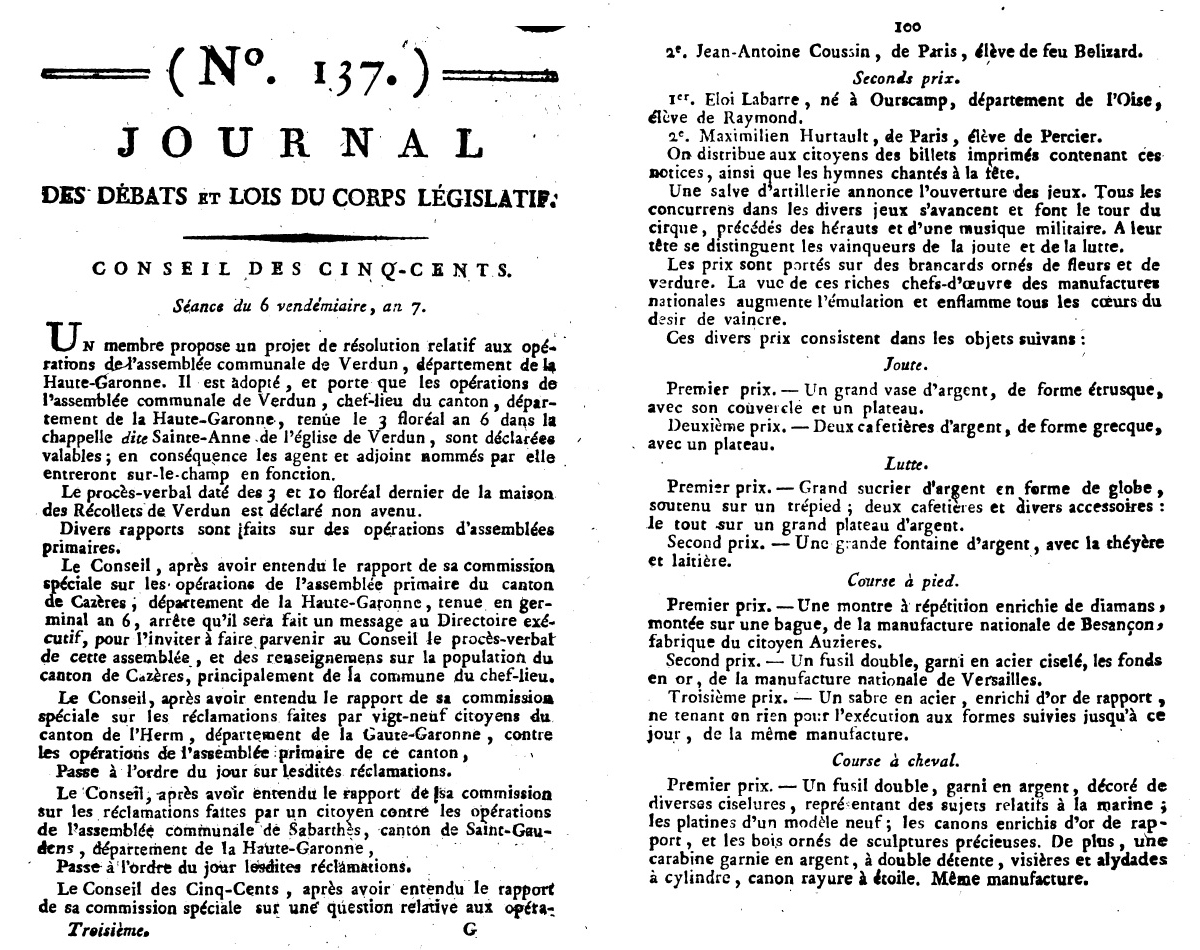|
Disclaimer: The views and opinions expressed in these articles are those of the authors and do not necessarily reflect the official policy or position of Wrestling-Titles.com or its related websites.
The material for this report was collected and researched by Ruslan C Pashayev of Columbus, Ohio, USA and Christian Gaildraud of Limoge, France.
Dear Friends, recently in the No 348 issue of the Gazette Nationale ou Le Moniteur Universel, dated September 4, 1798 (Octidi, 18 Fructidor, An 6) I was very lucky to find an article which spoke about a certain wrestling tournament that was held on the Champs de Mars on September 22, 1798 (Vandemiare 1, An 7) in Paris, France. This competition along with some other field sports was part of the celebrations of the Festival of the Foundation of Republic.
That wrestling tournament of 1798 is the earliest (!!!) known to me organized championship wrestling competition in modern French history.
From the newspaper report we learn about the Rules which governed that sporting event:
“La lutte succédera. Ce jeu s'exécutera dans une portion de la moitié septentrionale du cirque. Les lutteurs seront divisés en deux bandes, l'une dis-tinguée par des couleurs bleues, l'autre par des couleurs rouges. A un signal, les deux partis s'avanceront l'un vers l'au-tre chacun des concurrens cherchera à renverser, à force de bras, l'adversaire que le hasard aura placé de-vant lui. Celui qui tombera sera obligé à l'instant de donner au vainqueur les rubans qui distinguaient le parti dans le-quel il combattait, et une carte qui contiendra son nom. Des appariteurs nombreux répandus parmis les combat-tants veilleront à ce que cette loi de la lutte soit ponctuel-lement exécutée. Le bureau central sera juge de la lutte. Il décernera les prix aux deux concurrents qui auront à montrer le plus de rubans et de cartes du parti opposé.”
“This will be followed by a wrestling competition. This game will be performed in the part of the northern half of the circus. The wrestlers will be divided into two groups, one distinguished by the blue colors, the other by the red colors. At a signal, these two teams will advance towards each other; each of the competitors will try to overthrow, by force of arms, the adversary that chance has placed in front of him. The one who falls will be obliged immediately to give to the winner the ribbons that distinguished the party in which he fought, and a card that will contain his name. Numerous attendants among the combatants will see that this law of wrestling is punctually executed. The central office will be referee of the wrestling competition. It will award the prizes to the two competitors who will have to show the most ribbons and cards of the opposing party”.

Notably, there is an old print (Inv. D. 15872. Entry no. E. 22437) in the collections of the Carnavalet Museum (Paris) called: Figure 9. III 2. Cinq représentations de participants à des fêtes du Directoire (1796 et 1798). Figure 9. III 2. Five representations of participants in Directory festivals (1796 and 1798). Among the images of other participants of the festival the image of the wrestler also appears on it followed by this description:
«Costume des luteurs à la fête du 1er Vendemiaire an 7. ils étoient seize. 8 ceinture Bleu et 8 Rouge.» "Costume of the wrestlers at the festival of the 1st Vendemiaire, year 7. There were sixteen of them. 8 blue belts and 8 red belts."

The wrestler is shown on this picture is wearing a headband, the runner shoes, slim-fit pants, a tight fit no-sleeves red jersey and a blue belt emblematic of the team he represents.
After making this fantastic discovery, I continued my research of this important historical event and again was lucky to find a very detailed newspaper report which provided additional information regarding the rules of that competition along with some description of the combats, as well as the names of the champion and the runner-up of that tournament.
The champion of the 1798 tournament was a resident of Paris called Charles-Pierre Oriot, aged 33, who was the butcher from the rue de la Grande-Truanderie; and the winner of the second prize was another Parisian called Digot, aged 34, the hosier from the rue de la Vieille-Draperie. The winner received a silver coffee service on tray and the runner-up a silver tea service.
To the best of my understanding during the times of Directory in France (1795-1799) they started promoting republican traditions and democratic values of ancient Greeks, because I believe the French saw themselves and the Republic they established in France a direct successors of the Greek Democracy of Antiquity. That is why the celebration of the Foundation of Republic featured the Games very similar to those of ancient Greeks of which wrestling matches always have formed an essential part. And I think that is exactly why the style of wrestling they chose was a copy of the Grecian Orthopale, of course according to the best of their knowledge and understanding of that subject.
To resume the above said I would like to add that according to the rules it was a single elimination tournament which featured two teams (reds and blues) each of eight wrestlers; and started with the round of sixteen. The style of wrestling was that of a standing (upright) manner with only holds above the waist being allowed. Wrestling only with the strength of arms was legit, and the use of legs and feet for throwing was strictly prohibited. To win the match it was required to floor your opponent with or without following him to the ground.
Considering the above it is obvious that the 1798 tourney was conducted under the rules of the style which was known as the Lucta Brachialis (holds above the waist only, wrestling only with arms, no tripping allowed, upright form of wrestling, no wrestling on the ground allowed). This style was the most common wrestling mode in France, Italy, Germany and Low Countries throughout the Middle Ages and the Renaissance. In France this particular style of wrestling, the Lucta Brachialis, in the 19c was known as the Lutte Lyonnaise/Lutte d’Hommes, a detailed information on which can be found in my article called The Mystery of French Wrestling Solved (2025).
Interestingly, the rules very similar to those of the 1798 tourney governed the Strongmen’s Wrestling matches when they were part of the annual World’s Strongest Man contest.
Enjoy the read!
(N°. 133.) JOURNAL DES DÉBATS ET LOIS DU CORPS LÉGISLATIF.
Dated: 2 vendémiaire, An 7 (September 23, 1798). Pages 34-40.
"Dans la partie septentrionale, près des bords de la rivière, avoit été formée une vaste arène pour les exercices de la lutte. Deux figures, d'énorme structure, y représentoient, l'une, le fanatisme à l'air hypocrite, armé d'un poignard, commandant le meurtre au nom du ciel; l'autre, le despotisme farouche, tenant à la main un glaive ensanglanté, et insultant à la misère des peuples opprimés."
“Ces exercices sont à peine achevés, que la trompette appelle les citoyens au spectacle de la lutte. En un moment les bords de la rivière sont dégarnis; la foule se porte sur les talus qui environnent l'arêne.
Seize athlètes y attendoient le signal du combat; ils sont divisés en deux bandes: l'une distinguee par des couleurs bleues, f'autre par des couleurs rouges.
Le bureau central, établi juge de la lutte, en proclame les conditions: les deux partis doivent s'avancer l'un vers l'aurre; chacun des concurrens cherchera à renverser, à force de bras, l'adversaire que le hasard aura placé devant lui; celui qui tombera sera obligé de donner à l'instant au vainqueur les rubans qui distinguent le parti dans lequel il combat.
Des appariteurs nombreux, répandus dans l'arène, sont chargés de veiller à ce que cette loi de la lutte soit ponctuellement exécurée.
Un orchestre, placé dans l'arène, exécute des airs guerriers. Le signal se donne les seize athlètes s'avancent l'un vers l'autre et še saisissent; tout ce que peut la souplesse, la force, l'agilité, la ruse, est mis tour-i-tour en usage par ces robustes luteurs ils se serrent, se poussent, se heurtent; enfin la force est obligée de céder à la force; huit d'entre eux sont étendus sur la poussière. Les appariteurs s'avancent pour aider aux vaincus à se relever. Les spectateurs donnent des applaudissemens à leurs efforts, et les consolent de leur défaite.
Une seconde lutte s'engage entre les huit vainqueurs; ils font également des prodiges de vigueur et d'adresse; les spectateurs sont long-temps en suspens sur le sort du combat; un dernier effort est vaincu par un effort plus heureux; quatre des combattans tombent sous le corps de leurs adversaires.
Les quatre vainqueurs, sans reprendre haleine, se retournent et fondent l'un sur l'autre, deux contre deux, avec l'impétuosité de la foudre. Ce choc terrible décide de la victoire; deux des athlètes sont ébranlés, perdent l'équilibre, et roulent sur l'arène, les deux autres, les citoyens Digot et Oriot, restent vainqueurs de la lutte.
Des fanfares célèbrent leur victoire, et les citoyens leur donnent les plus vifs applaudissemens.
Une dernière lutte doit décider lequel de ces deux rivaux aura le premier prix. A peine ils se donnent le temps de respirer; déja ils sont en présence, et demandent le signal du combat,
La trompette répond à leur impatience: ils s'avancent l'un vers l'autre, s'arrêtent, s'observent et se mesurent quelque temps des yeux, en étudiant les moyens de se saisir avec le plus d'avantage.Le citoyen Digot l'emporte par la taille et la souplesse, le citoyen Oriot a plus de roideur et d'àpiomb. Le citoyen Digot livre a son adversaire des assauts répétés; il le pousse, il le presse, mais le citoyen Oriot reste inébraniable sur ses pieds. Un pro-fand silence règne dans toute l'assemblée pendant ce combat; les inclinations se partagent pour l'un ou l'autre des lutteurs; chacun fait des varux secrets pour celui auquel il s'intéresse. La faveur publique ranime leur ardeur et redouble leurs forces, le citoyen Oriot parvient enfin à saisir son rival au corps; il le serre étroitement dans ses bras, et l'enlevant de terre, le terrasse et tombe luimême sur lui.
Les appariteurs déclarent la lutte finie. Le citoyen Oriot présente la main à son rival pour le relever et l'embrasse au milieu des acclamations et des applaudissemens des spectateurs.
La musique exécute des chants de victoire. Le bureau central proclame premier vainqueur de la lutte, le citoyen Charles-Pierre Oriot, âgé de 33 ans, boucher, demeurant à Paris, rue de la Grande-Truanderie; et second vainqueur dans le même exercice le citoyen Digot, bonnetier, âgé de 34 ans, demeurant aussi à Paris, rue de la Vieille-Draperie.
Après ces jeux, deux grands chars de forme antique, ornés de lauriers et de divers emblêmes de la souveraineté du peuple, font le tour du Champ, s'avancent dans l'arène. Ils portent des groupes de citoyens qui figurent le peuple français; tous ont des couronnes de chêne et de laurier.
L'un des chars a pour inscription:
Le peuple français vainqueur an 14 juillet.
L'autre char:
Le peuple français vainqueur au 10 août.
Les citoyens qui occupent les deux chars descendent vers le milieu de l'arène, et s'armant de flambeaux allumés, mettent le feu aux figures hideuses du Despotisme et du Fanatisme.
Ils forment ensuite des danses autour du bûcher; les orchestres jouent des airs patriotiques. Tous les citoyens applaudissent; chacun d'eux se dispute le plaisir de lancer un brandon sur les deux monstres qui ont désolé la France pendant tant de siècles. L'air ça ira, premier soupir de la liberté renaissante, est joué et redemandé avec transport pendant cette expiation civique.
On ne remarquoit pas que le soleil avoit fourni la moitié de sa course: des hérauts, précédés de trompettes, appellent à un banquet fraternel les vainqueurs dans la joûte et dans la lutte. Une table avoit été servie pour eux sous une tente: ils s'y asseyent au milieu des juges des jeux.
Un grand nombre de citoyens vont aussi s'asseoir à d'autres tables, er sous de vastes tentes qui avoient été préparées pour le public dans les allées latérales du cirque. La joje et l'alégresse contingent à animer ce repas de famiile; de nombreux toast sont portés à la République, à ses fondateurs, aux armées républicaines de terre et de mer, à la constitution de l'an 3. Les autres citoyens se répandent sous les portiques où sont exposés les produits de Pindustrie française et vont admirer les différens chefs-d'œuvre qui y sont étalés.” 

(N°. 137.) JOURNAL DES DÉBATS ET LOIS DU CORPS LÉGISLATIF.
Dated: 6 vendémiaire, An 7 (September 27, 1798). Page 100.
Ces divers prix consistent dans les objets suivants:
Lutte.
1º prix. Grand sucrier d'argent en forme de globe, soutenu sur un trépied; deux cafetières et divers accessoires, le tout sur un grand plateau d'argent.
2º prix. Une grande fontaine d'argent, avec la théière et la laitière. 
(No. 133.) JOURNAL OF DEBATES AND LAWS OF THE LEGISLATIVE BODY.
Dated: 2 vendémiaire, An 7 (September 23, 1798). Pages 34-40.
"In the northern part, near the banks of the river, a vast arena had been formed for wrestling exercises. Two figures, of enormous structure, represented it: one, fanaticism with a hypocritical air, armed with a dagger, commanding murder in the name of heaven; the other, fierce despotism, holding a bloody sword in his hand, and insulting the misery of oppressed peoples." “These exercises were barely completed when the trumpet called the citizens to the spectacle of the wrestling. In a moment, the banks of the river were cleared; the crowd rushed to the embankments surrounding the arena”.
Sixteen athletes awaited the signal to begin the fight; they were divided into two teams: one distinguished by blue, the other by red. The central office, established as judge of the fight, proclaimed the conditions: the two parties must advance toward each other; each competitor would attempt to overthrow, by force of arms, the opponent whom chance had placed in front of him; the one who fell would be obliged to immediately give the winner the ribbons that distinguished the party in which he was fighting.
Numerous attendants, scattered throughout the arena, were responsible for ensuring that this law of the fight was punctually executed. An orchestra, placed in the arena, played warlike airs. The signal was given, the sixteen athletes advanced toward each other and seized each other; All that flexibility, strength, agility, and cunning can muster is put into use by these robust wrestlers; they squeeze, push, and collide; finally, strength is forced to yield to strength; eight of them are stretched out on the dust. The attendants come forward to help the vanquished to get up. The spectators applaud their efforts and console them for their defeat.
A second fight ensued between the eight victors; they also displayed prodigies of vigor and skill. The spectators were left in suspense for a long time as to the outcome of the combat. A final effort was defeated by a more successful one; four of the combatants fell under their adversaries.
The four victors, without catching their breath, turned and charged at each other, two against two, with the impetuosity of lightning. This terrible clash decided the victory; two of the athletes were shaken, lost their balance, and rolled across the arena; the other two, citizens Digot and Oriot, remained victorious in the fight.
Fanfares celebrated their victory, and the citizens gave them the loudest applause.
A final fight was to decide which of these two rivals would take first prize. They barely had time to breathe when they were already face to face, calling for the signal to begin the fight.
The trumpet responds to their impatience: they advance towards each other, stop, observe and size each other up for a while, studying the means to gain the most advantage. Citizen Digot wins by size and suppleness, Citizen Oriot has more rigidity and aplomb. Citizen Digot delivers repeated assaults to his opponent; he pushes him, he presses him, but Citizen Oriot remains unshaken on his feet. A profound silence reigns throughout the assembly during this combat; inclinations are divided between one or the other of the wrestlers; each makes secret attacks for the one in whom he is interested. Public favor rekindles their ardor and redoubles their strength; Citizen Oriot finally manages to seize his rival around the body; he clasps him tightly in his arms, and lifting him from the ground, knocks him down and falls on top of him himself. The attendants declare the fight over. Citizen Oriot offers his hand to his rival to raise him up and embraces him amidst the cheers and applause of the spectators.
The band plays victory songs. The central office proclaims the first winner of the contest: Citizen Charles-Pierre Oriot, 33 years old, a butcher, residing in Paris, Rue de la Grande-Truanderie; and the second winner in the same contest: Citizen Digot, 34 years old, a hosier, also residing in Paris, Rue de la Vieille-Draperie.
After these games, two large antique-style chariots, adorned with laurels and various emblems of the people's sovereignty, circle the Champs-Élysées and advance into the arena. They carry groups of citizens representing the French people; all wear oak and laurel wreaths.
One of the chariots bears the inscription:
The French people victorious on July 14.
The other chariot:
The French people victorious on August 10.
The citizens who occupy the two chariots descend towards the middle of the arena, and arming themselves with lighted torches, set fire to the hideous figures of Despotism and Fanaticism.
They then formed dances around the pyre; the orchestras played patriotic tunes. All the citizens applauded; each of them vied for the pleasure of throwing a firebrand at the two monsters who had devastated France for so many centuries. The tune " ça ira" the first sigh of reborn liberty, was played and repeated with rapture during this civic expiation. No one noticed that the sun had sunk halfway: heralds, preceded by trumpets, called the victors in jousting and wrestling to a fraternal banquet. A table had been set for them under a tent; they sat there among the judges of the games. A large number of citizens also went to sit at other tables, and under vast tents that had been prepared for the public in the side alleys of the circus. Joy and merriment were the order of the day to enliven this family meal. Many toasts are made to the Republic, to its founders, to the Republican armies of land and sea, to the constitution of the year 3. The other citizens spread out under the porticoes where the products of French industry are exhibited and go to admire the various masterpieces which are there.”
(No. 137.) JOURNAL OF DEBATES AND LAWS OF THE LEGISLATIVE BODY.
Dated: 6 vendémiaire, An 7 (September 27, 1798). Pages 100.
These various prizes consist of the following items: Wrestling. 1st Prize. Large silver sugar bowl in the shape of a globe, supported on a tripod; two coffee pots and various accessories, all on a large silver tray. 2nd Prize. A large silver fountain, with a teapot and milk jug.
NOTE: the copy of this newspaper article also appeared in the issue of LE RÉDACTEUR, N°.1013. Dated Du 4 Vendémiaire (September 25, 1798). 
Ruslan C Pashayev is an expert-member of the Traditional Sports Team of the Instytut Rozwoju
Sportu i Edukacji
(the Institute of Sport Development and Education), Warsaw, Poland.
© 2025 Ruslan C Pashayev All Rights Reserved.
|
